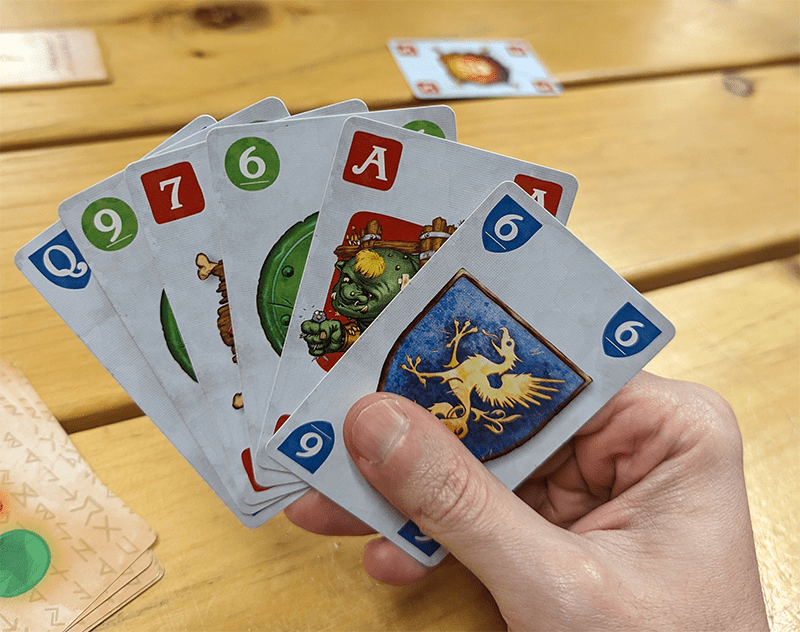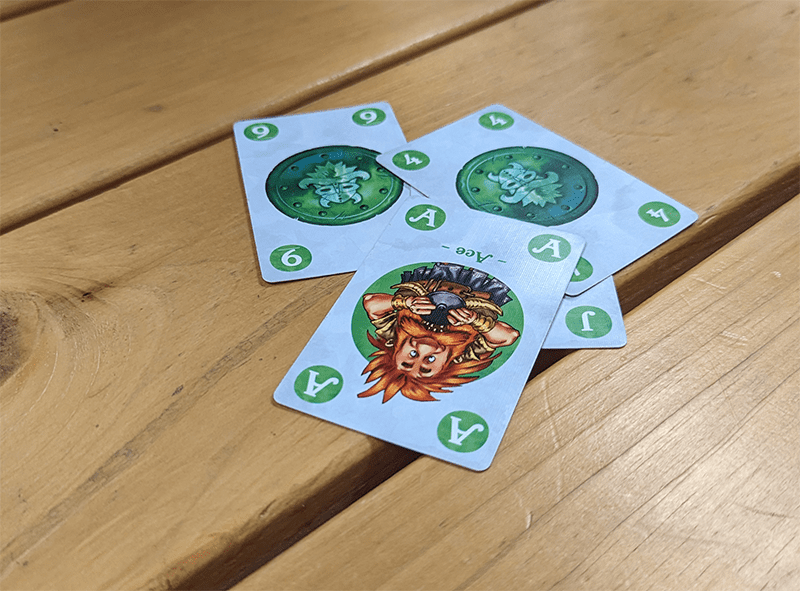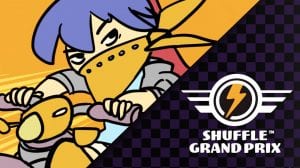Disclosure: Meeple Mountain received a free copy of this product in exchange for an honest, unbiased review. This review is not intended to be an endorsement.
Trick-taking games are one of the easier genres to get into when it comes to board games. Most of them are simply a deck of cards, a concept the entire world understands, and the rules are mostly straightforward. While some like Bridge and Cribbage can be more complex, most trick-taking games are easy to learn compared to modern board games.
Modern board game publishers are certainly prone to chasing trends, like deckbuilding, social deduction, roll and writes, and legacy games. Lately, trick-taking games seem to be having a moment. As a reviewer, I appreciate this since the key mechanism is so well-known that I don’t need to explain the core gameplay in detail. Just saying a game is a “trick-taking” game conveys the basics of following suit, playing one card, and winning tricks with the highest card.
Which is why the reprinting of The Dwarf King makes perfect business sense. Originally released in 2011, this lightweight card game with simple “Quest tiles” flew under the radar in North America. It’s quite accessible with its minimal components—playing cards, Quest tiles, and a thin rulebook. The only thing you’ll need to grab on your own is a scorepad, making this game feel like it was released over ten years ago.

Familiar Trick-Taking Foundation
Since this is a Bruno Faidutti game, a French designer known for interjecting chaos into his games, what’s the deal with this one? Let’s start with that deck. It’s only three suits with the typical face cards of Jack, Queen, King, and Ace. There’s also number cards from 1 to 11, except the 1 or 11 number cards might not show up since every round has a special card thrown in. These special cards break the rules a bit, such as introducing trump cards, scoring or losing points, and forcing players to swap hands.
That doesn’t sound too weird, but then you start peeking at the Quest tiles and suddenly you can begin to piece together what type of game this is going to be. There are 7 rounds, represented by the stack of double-sided 7 quest tiles. After the cards are dealt out, whoever has the Blue 5 card takes the top Quest tile and picks what Quest this round will be.
The unique twist in The Dwarf King is the Quest tiles, which determine the method of scoring each round. They dictate unconventional rules on how to score points that can make or break your stride. With constantly shifting goals, players can’t rely on standard trick-taking wisdom. Instead, you need to tune your plans each round based on the Quest tile’s special scoring rules. This clever use of changing objectives sets The Dwarf King apart from other trick-takers and doesn’t make the game feel too repetitive.
Twisting Tricks with Quest Tiles
I obviously won’t list all of them, but I’ll paint a picture with a few examples. Some of the more positive ones are scoring points for specific cards or suits, winning a certain number of tricks, or having your neighbors win tricks. On the flipside of that, certain Quest tiles can make you lose points for winning a row of tricks or “winning” certain cards. There are also quests that are a mix of both.
The Dwarf King follows standard trick-taking gameplay with a few twists. Each round starts with the player holding the Red 5 leading the first trick. Players must follow suit if possible, otherwise they can play any card from their hand. The player who plays the highest card in the leading suit wins the trick and starts the next one. Unlike most games in this genre, The Dwarf King features a special “rule breaking” card that impacts gameplay for that round that is announced before the cards are dealt.
The Dwarf King makes no apologies for its old-school gameplay. It wholeheartedly embraces the nostalgic, no-frills mechanics of classic games like Hearts. There are no glossy innovations here, just a solid rendition of familiar card play. If you have fond memories of trick-taking and enjoy the purity of that barebones style, The Dwarf King will play with your insides far better than eating spoiled food. But if you require cutting-edge ideas and lavish production, this understated throwback has little to offer.
Swings and Roundabouts
Now for those of you still here, is The Dwarf King the perfect trick-taking game for people new to the genre? Almost. I’ve taught this game to people of a younger generation who never played these types of games quite easily. However, this is a Bruno Faidutti game, and he is famous for intentionally inconsistent gameplay.
I’ll start with an easy target: Player scaling. At 3 or 4 players, The Dwarf King works perfectly fine. It’s when you hit that 5 player limit that you start seeing some problems when you squint at some of the Quests. At 5 players, you only have 8 tricks to play in a hand. Now let’s say someone decides to pick a quest where you can only score points if you win exactly 5 tricks. That’s going to be a major problem. The likely outcome is that nobody scores, making point progression in 5 player rounds feel flatter than an airport runway.
The Dwarf King also has swingy scoring from session to session due to the large variety of Quest tiles, even with just 4 players. This provides great replayability, but inconsistent point spreads. In my experience, some games saw 18+ points, while others had a “winner” with 2 points and last place at -10 points. Some players will undoubtedly be frustrated by the wild point discrepancies between games. The high randomness means you never know if it will be a low-scoring nail-biter or a high-scoring fist fight.

Old School Cardplay at its Finest
It’s also why I enjoy this one quite a bit. Forcing me to evaluate my hand with a new set of eyes every round does make this one an engaging experience. Some rounds want me to win tricks and maneuver my cards through the trick-taking bureaucratic process, while others want me to avoid them like a Rian Johnson film. It makes the 7 rounds not feel like the slog I’ve had with similar games like Wizards and Skull King where I am constantly doing the same bit over and over again.
To give one example: I had one Quest where every blue card scored a point, but the green cards would make you lose a point. Most of my hand was green. Instead of winning tricks, my game plan for the round was to play green cards off-suit to make everyone bleed with me. It was memorable enough for me to write a few sentences about it.
The Dwarf King is unlikely to convert trick-taking skeptics, but it’s a delight for those who enjoy traditional cardplay. While the randomness of the Quest tiles may frustrate those looking for consistency, it provides decent replayability for trick-taking fans. For those seeking an accessible entry point to the genre, The Dwarf King‘s refined execution is a great starting point. Despite its barebones look, there’s charm to be found in this modest throwback. The Dwarf King may not break new ground, but it proudly celebrates the traditions of trick-taking’s glory days.











Add Comment